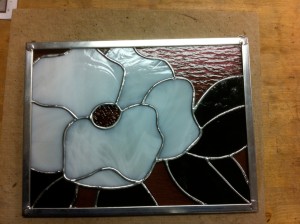Patinas are used to color or darken solder lines. The most common patina colors are black and copper. Using patinas brings the focus on the glass and the design of your stained glass piece. This makes the glass colors, textures and designs of the stained glass piece the main focus. Below is one without patina and one after patina.


Before you apply patinas, be sure all flux residues is removed. This can be done using a commercial flux remover or washing the stained glass piece with dish soap and baking soda.
Steps for Applying Patinas
Use a brush, rag or cotton ball to dab patina on to the zinc frame. Do not use a brushing action, as this can leave streaking or patchy coverage.Next, apply patina to solder lines. Be sure all edges of solder lines have been covered.
Then, turn project over and repeat the process on that side.
Lastly, thoroughly rinse the patina off the stained glass piece. After it is completely dry, a minimum of 24hours, finishing compound can be applied.
Tips and techniques for Applying Patinas
Safety Always wear rubber gloves when applying patina.
If patina appears spotty, use super fine steel wool to clean the area, and then re-apply the patina.
To avoid oxidation, clean and apply patina immediately after project is soldered.
While patina will mask some inconsistencies in you solder lines, others will still be noticeable and take away from the professional look of your piece. With patience, practice and the correct tools and supplies, you can have professional solder lines.
Most patinas come in an 8 oz bottle. Avoid contaminating the liquid in the bottle by never re-dipping your applicator back into the bottle. Pour out a lid full and use this as your re-dip point.
You may experience different end results with the use of different brands of patinas. One common brand and easily found on store shelves and on line is Novacan. It is available in different formulas for different metals i.e. lead vs. zinc. As you experiment with different brands, you will notice that the more expensive ones do seem to shine more. Sometimes simple wax and compound can help this situation too.
Usually, if need be, patinas can be removed by using steel wool and some elbow grease. So don’t fret if you think the application has made your art work look bad or if you just don’t like the shiny lines dark.
I was not a fan of most patinas; however, I now know that by using this product, you do experience brilliant colorful glass. All attention is quickly turned from solder lines to the subject of your glass creation the glass.
Another note of concern applies to patinas as well as other chemicals used in stained glass production. That is evaporation. Be sure and keep the lids tightly screwed on your bottles of supplies as some do seem to disappear into thin air. This will also avoid waste if tipped over accidentally.
 Posted in
Posted in  Tags:
Tags: 